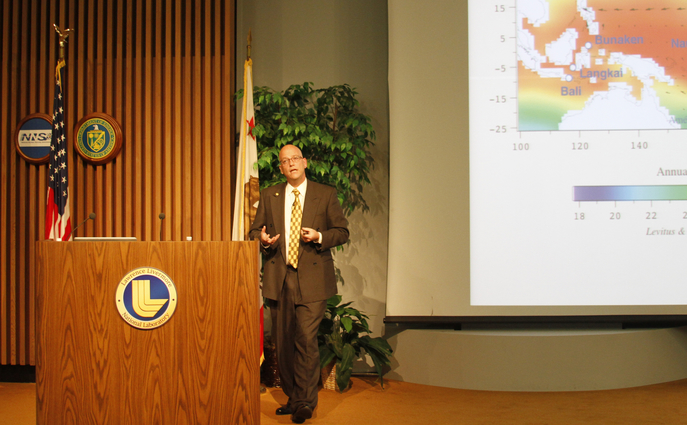Guilderson takes the guess work out of climate change
 (Download Image)
Tom Guilderson
(Download Image)
Tom Guilderson
That was the subject of Guilderson's talk "Radiocarbon: Chronometer and Geochemical Tracer of the Carbon Cycle," Tuesday, as part of the 2012 Director's Distinguished Lecturer Series.
Guilderson is the recent winner of the E.O. Lawrence Award for his groundbreaking radiocarbon measurements of corals, advancements in understanding the paleohistory of ocean currents and ocean processes revealing past climate variability and the elucidation of how physical and biogeochemical oceanic processes affect the global carbon cycle.
Guilderson has reconstructed paleoclimate variability over the last 50,000 years, and using radiocarbon dating has placed it on a firm chronology.
On Tuesday, he discussed how devastating droughts in ancient times not only affected water resources but the civilizations in these regions. For example, a 200-year drought in Guatemala coincided with the collapse of the Mayan empire near 800 AD. Similar coincidences between drought and collapse of city-states and or civilizations occurred during the Akkadian empire (~2200 BC), and even more "locally" (in space and time) with the Anasazi.
"CO2 is a positive feedback on the climate system," Guilderson said.
Guilderson also mentioned how his studies of corals showed how CO2 affected ocean temperatures. "Reef-building corals act like strip-chart recorders of the ocean in which they live in, and we can reconstruct surface temperature and other ocean properties (e.g., carbon 14, or 14C, content). The oceans are a sink of carbon dioxide and are still taking it up."
Radiocarbon (14C), a naturally occurring but very rare (one-in-a-trillion) isotope of carbon with a half life of approximately 5,730 years, is routinely used in the earth sciences as a radiometric dating tool. Once produced, it is rapidly oxidized to carbon dioxide and mixed into the atmosphere, where it is entrained into the global carbon cycle.
As a geochemical tracer, natural-abundance radiocarbon can be used to clarify and document mechanistic processes in the partitioning of carbon between the atmosphere, ocean, and the terrestrial biosphere on scales of centuries to millennia.
Guilderson discussed how he used the "bomb curve" and ocean general circulation models to study the uptake and redistribution of anthropogenic carbon in the oceans.
From the mid-1950s until the moratorium in 1963, atmospheric weapons testing approximately doubled the amount of radiocarbon in the atmosphere, which in turn provided earth scientists and carbon cycle researchers with an Earth-system-wide pulse tracer experiment that has been used to determine stratosphere and troposphere exchange, air-sea CO2 exchange and a unique tracer experiment to study ocean circulation and the broader carbon-cycle.
Contact
Anne M Stark[email protected]
925-422-9799
Tags
Earth and Atmospheric ScienceClimate change
Physical and Life Sciences
Science
Featured Articles







